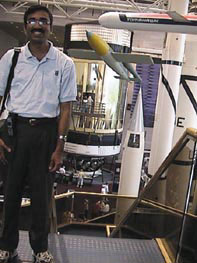Arts
Itsy Bitsy Spider

Indians are beginning to crop up in next generation designs.
|
Buildings made of spiders’ webs, sandals that clean the earth, crockery constructed from corn, furniture that is grown rather than manufactured, and garbage bag mini-skirts. Sounds weird, impossible and a bit wacky?
Well, these were some of the 204 entries in Metropolis magazine’s Next Generation contest, creative ideas of a whole new generation of young designers and indicative of the trends you might see in the future in design. With Indians popping up everywhere, it wasn’t surprising to see a handful of desi names cropping up here too. The winner of the prize was a young Boston design firm, Single Speed Design, whose innovative proposal transforms abandoned, dismantled sections of a huge elevated highway in Boston into the Big Dig apartment buildings. Talk about turning life’s lemons into sweet lemonade! In a related collaboration with the International Contemporary Furniture Fair, about 20 of these designs were collected together for an exhibition – Raw: The Next Generation, at the Jacob Javits Center in New York. The ideas were all innovative, some radical, and some environmentally friendly in today’s changing world. Karin Carter, who was born in India and raised in Denver, came up with the concept of SLiK fabric developed as part of her thesis project on sustainable fashion. She used plastic shopping bags to create snazzy SLiK clothing: a non-woven textile made of 100 percent post consumer polyethylene film. So now there’s finally a use for all those Walmart shopping bags! Sandals that clean the earth is another feel good solution to the world’s environmental woes and these JohnnyAppleSandals were created by Lift, a design firm headed by Eric Bergman, which has Amit Mirchandani on its six-member team. These sandals disperse soil-cleaning seeds through channels embedded in the soles. With wear, the soles release seeds, some of which take root and clean the environment through phytoremediation, a process by which certain natural plants can destroy hazardous contaminants in the ground. So now you can save the world by merely putting one foot in front of the other – wearing the right footwear, of course.
While the Danish design team of Anne Bannick and Lene Vad Jensen had come up with PAPCoRN, plates, bowls and cutlery made out of Bioplast, a biodegradable thermoplastic derived from cornstarch, Abhijit Bansod came up with an intriguing concept, a Karmameter! Bansod, who did mechanical engineering in Nagpur, is a product design post-graduate from National Institute of Design, Ahmedabad and works for Titan Design Studio in Bangalore. He bases the concept of the Karmameter on the Bhagvad Gita, which teaches that individuals must accept the consequences of their actions. “The unfortunate fact is that the world is an exhaustible resource at a crisis point and citizens of a democracy have duties that complement their rights,” he says. “We are not helpless; and man can never be certain that there is no afterlife or rebirth where actions in this life are tallied up and made to count at some subsequent time!” Buying stuff never felt so good! With Abhijit Bansod’s Karmameter, shopping becomes almost a moral issue. In fact, as Bansod suggests, design takes the lead in fomenting a morality induced cultural discourse. It involves a voluntary system where the designers, the government, industry and consumers sign up and work together; smart technology is designed and built into products that are manufactured. Under this system every product that is designed, and subsequently manufactured by industry, is assessed a certain number of points. These points take into consideration the “environmental” expense to manufacture, use or consume, and dispose the product.
Whenever a product, recognizable by the Karmasun logo is purchased, the purchaser must provide his karmameter, where points are deducted against the total. If the product is used in an optimal way and disposed in a proper manner, points are added to the individual’s account. These points increase or decrease on the individual’s Karmameter with every purchase and every disposal. If the consumer is involved in purchasing recyclable products, using biodegradable ingredients, points are added. At the end of allocated periods the points can be used for redeemable purchases, tax rebates and benefits, holiday schemes, or charitable donations. At Titan, Bansod is involved in product design of everything from vases to picture frames and watches, and his designs are fresh and whimsical. His latest lifestyle accessories collection is Lifethings, fun items that bring cheer into daily living. It is only in India, one thinks, that prosaic engineering students are also poetry enthusiasts. In fact, Lath who came to the United States from Jaipur to study electrical engineering got the concept for Optrix after reading the following poem: I repeat my vow “Translating this poetic idea into a physical form, one that is able to provide a corresponding sensory experience of the imagery while being abstract enough to be removed from ‘the bamboo forest’ and become a thing in itself, resulted in Optrix,” says Lath. The material is created from acrylic or Plexiglas into which light conducting channels are carved, these then carry light and color within the material. As he explains it, the basic Optrix system consists of two parts. A transparent material that acts like a conduit for light and a substrate that it is embedded in: “Together this composite either reacts to the presence of light by redirecting it or reacts to the absence of light by reconfiguring shadows.” Lath first started making things with his hands in his mother’s design workshop, and later got interested in robots, building a large one for the Birla Science Museum, just after high school. His interest in robotics brought him to the United States to pursue electrical engineering at Arizona State University. Last year he also completed his MA in architecture from the University of Michigan.
With help of the University of Michigan, Lath has applied for a comprehensive utility patent. He is forming a company that will explore the commercial possibilities of SensiTile, and is doing an installation for Digital Globalsoft, an Indian subsidiary of Hewlett Packard, in Bangalore. Lath’s journey as an inventor started early. “I had started building small robots quite early on in school. By 12th standard I was making pretty complex ones that could move around and pick up things and had some degree of automation. These caught the eye of the young director of the new Birla Museum and Planetarium that was coming up in Jaipur and he talked me into building a very large and complicated robot for the Museum. The robot would show the visitors around the museum. It took me about a year to complete this machine and since there were no parts specifically available for a robot in Jaipur in those days, it was made with recycled automotive and other odd parts. The head as you can see is made from a motorcycle helmet! The completed machine could roam around and had a fully functional arm. It had a tape recorder to talk and the lips were synchronized to its speech so that it would seem to talk! Which finally brings us to the astounding notion that spiders’ silken webs could reinforce entire buildings! Yallayi Raja Viswanadhan who graduated with a B.A. in architecture from REC Bhopal and an M.A. in construction management in the United States, came up with this futuristic concept that seems right out of science fiction. He says, “It’s a fiber, which has evolved over 400 million years, and it’s just one-tenth of the diameter of a human hair and if it can stop a bee traveling at 20 miles an hour, I guess there’s a possibility that this fiber can be combined with other materials to develop structural elements that can be effective in resisting wind and other forces such as the attack on the World Trade Center.” In his proposal, Viswanadhan explained that spider silk is stronger than all known materials and the dragline of the European garden spider can support a weight of 0.5 g without snapping, whereas a steel strand of similar thickness will snap under the strain of just 0.25 g. It is also five times more elastic than Kevlar and Kevlar is several times stronger than steel.
He points out that Nexia and the U.S. Army have mimicked the spider’s spinning process and produced recombinant silk for a wide range of applications and material composites and says, “So, probably in the near future, new fibers can be developed in place of steel to support curtain walls.” She gets numerous emails from Indian students on college campuses, who are very proud of their culture and want to present the maestro’s concerts through their Indian associations. She says, “That’s a piece of the pudding right there, that there are all these associations all over the place, all over the country.” So what is happening? Is it a full scale Renaissance, a revival of India’s great music and dance traditions? And why is it happening now? There’s a simple, one word answer – demographics. As the Indian American population has escalated to almost two million, the sheer numbers ensure an increased demand for such services, as immigrants, now well established, try to catch up on what they’ve missed and their American born children, who have come of age, hreflect on their roots. You have Indians everywhere, in major corporations, hospitals, and college campuses and of course, Silicon Valley. There’s wealth and a hunger to reconnect. “Our numbers are so much higher now that people feel hey, it’s ok to be part of the culture,” says Raja of YICG. “You have a larger pool, so you have more people who are good in dance, in music, in teaching. There’s leadership that’s thrown out when you reach critical mass.” She points out the generation, which came 30-40 years ago, pretty much wanted to blend in with the landscape and most of their cultural efforts were basement operations. Like the Irish and the Chinese before them, they tended to congregate in enclaves. Even though they had money and were educated, they did not build cultural institutions. “My theory is that they weren’t so comfortable with themselves and wanted to blend in, and their children too,” she says. “But what I see now is definite pride in oneself. It’s OK to be who we are, we want to keep our traditions, we want to preserve them, we want to learn them. The critical mass has been reached in certain areas.” |





